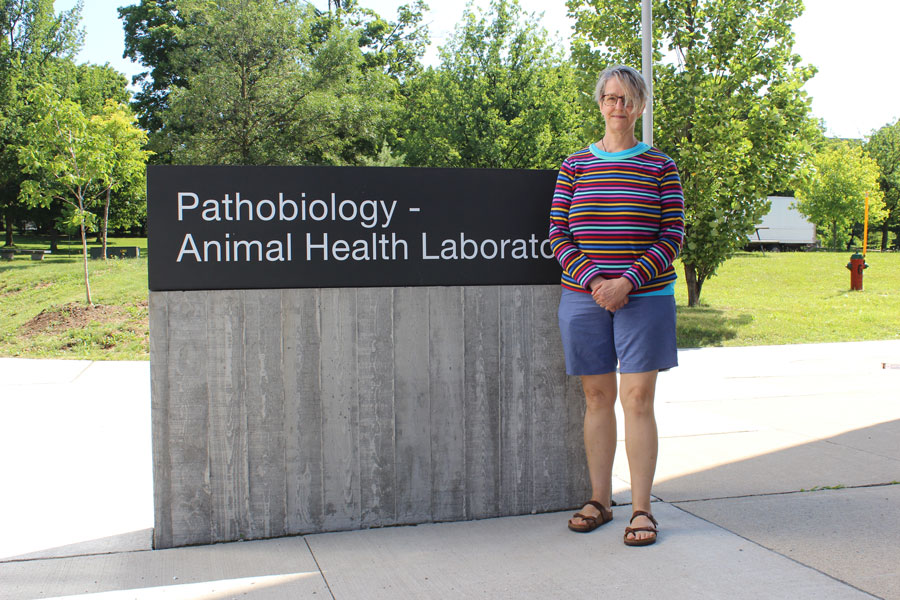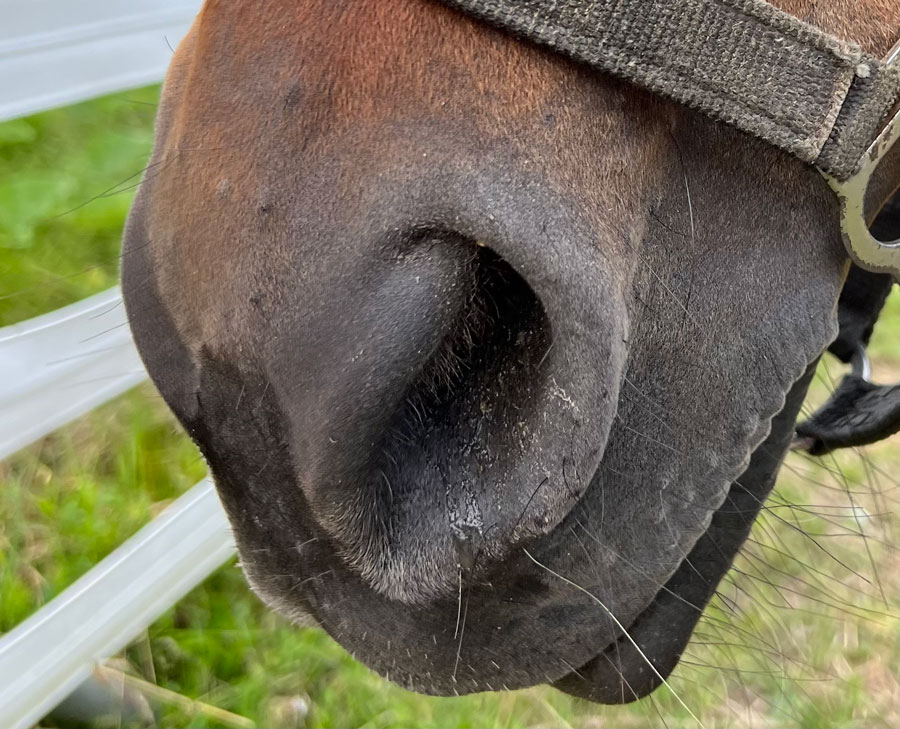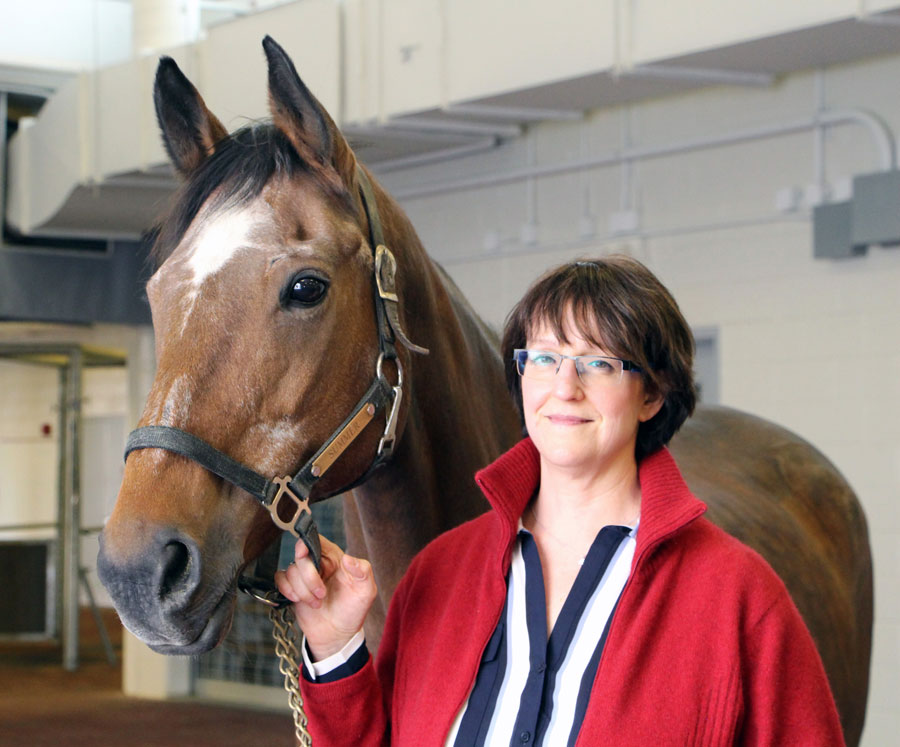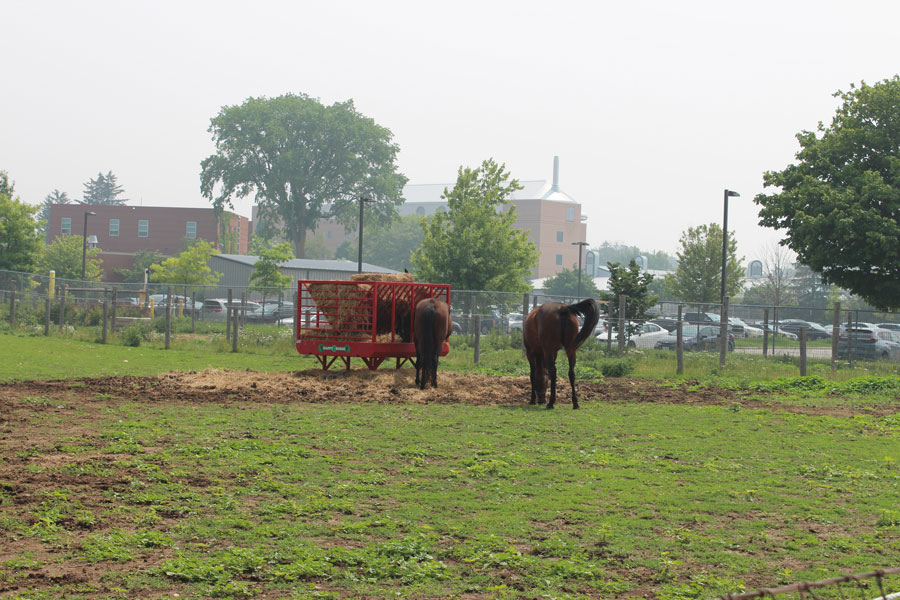GUELPH – When air thick with haze and the acrid smell of wildfire smoke pushes air quality health indexes to high levels, people are advised to remain indoors.
But what about animals?
The same advice holds strong, according to veterinary pathology specialist Janet Beeler-Marfisi, who is researching the relationship between air pollution and lung disease in horses, dogs and cats. She has been studying equine asthma specifically for 17 years.
Air pollution – including smokestorms, car smog, and dust particles – can cause lung damage in people, pets, and livestock, Beeler-Marfisi said during an interview with the Advertiser at the Ontario Veterinary College at the University of Guelph.

Janet Beeler-Marfisi is a veterinary pathology specialist who researches the relationship between air pollution and lung disease in horses, dogs and cats. She says smokestorms can have a serious impact on animals’ health. Photo by Robin George
Smokestorms and car smog have a lot in common, she noted. Both include gasses such as carbon monoxide, sulphuric acid, and benzene. Both have soot, and “worst of all,” particulate matter 2.5, Beeler-Marfisi said.
Soot consists of large carbon particles that are mostly filtered out by the nostrils when people and animals breathe, though they can still cause irritation, she said.
Particulate matter 2.5, however, is significantly smaller than soot particles, and can bypass filtration in the nose. At 2.5 microns in diameter, the particulate matter is 30 times smaller than a strand of human hair, enabling it to travel “way, way down into lungs,” Beeler-Marfisi said.
From there, the particles enter into the bloodstream in people, livestock, and pets.
Inhaling pollutants from smokestorms and smog can lead to lung diseases such as chronic obstructive pulmonary disease, bronchiolitis, asthma, lung cancer, and cardiovascular disease, she added.
And long-term exposure to severe air pollution can lead to irreparable lung damage and decrease an animal’s life expectancy, she said.
Signs animals are struggling
An animal struggling because of air pollution experiences similar symptoms to people, Beeler-Marfisi said, and because animals don’t have a voice to express how they’re feeling, people need to look out for the signs.
Symptoms include discharge from eyes or nostrils, with animals sometime pawing at their faces or rubbing their eyes.

Discharge from nostrils or eyes may be a sign that an animal is affected by poor air quality, said Dr. Janet Beeler-Marfisi. Submitted photo
Air pollution can make it harder for animals to breathe – causing them to breathe with their mouth open, or breathe more heavily or noisily than usual. They may even cough or gag.
If their breathing sounds wheezy, that’s a sign of asthma-like symptoms in horses or cats, Beeler-Marfisi said, or bronchitis in dogs.
Air pollution can also reduce animals’ thirst, appetite, and energy levels, so they may drink, eat, and move less than usual.
If you notice laboured breathing or significant discharge from the eyes and nose, Beeler-Marfisi recommends close monitoring.
If they are reluctant to move, are unsteady, disoriented, or not eating or drinking, she said it’s “definitely worth calling the vet.”
Protecting animals during smokestorms
Beeler-Marfisi recommends animals be kept inside if they’re showing respiratory symptoms and during periods of high risk air quality advisories or smokestorms, when smokey conditions affect daily life.
Up-to-date air quality info can be found by clicking or tapping here.
If you notice mild symptoms or poor air quality, Beeler-Marfisi recommends making the animal as comfortable as possible, and delaying any exercise or potentially stressful situations such as transportation.
She notes all animals benefit from protection from poor air quality, not just those showing symptoms or suffering with pre-existing conditions.
Recommendations for people during periods of poor air quality can generally be applied to animals to — if people shouldn’t be outdoors, animals shouldn’t be either.
“If you are healthy and experiencing burning eyes and a sore throat [due to smoke pollution], don’t make an animal exercise,” Beeler-Marfisi said.
During smokestorms, Beeler-Marfisi advises horses and other livestock be kept “in as neutral an environment as possible,” ideally a climate-controlled barn with minimal stressors.

Janet Beeler-Marfisi, a veterinary pathology specialist who researches the relationship between air pollution and lung disease in horses, dogs and cats. Submitted photo
Cats should stay inside, Beeler-Marfisi said, and dogs should be limited to quick bathroom breaks outside.
Instead of taking dogs for walks or playing fetch in the backyard, Beeler-Marfisi suggests playing training games indoors that engage their minds, noting brain exercises help burn off excess energy and “exhausts them mentally.”
For birds, the impact of air pollution is “so much worse,” than for mammals, Beeler-Marfisi said.
Birds have a high metabolic rate and breathe more, she said, adding pet birds should never be let outside during smokestorms, and chickens should be kept inside the coop or barn.
Improving air quality indoors
Beeler-Marfisi said it’s important to protect the air quality inside houses and barns, especially when outside air quality is poor.
She suggests all doors and windows be kept closed during smokestorms, and measures be taken to protect the amount of oxygen inside and to limit the amount of dust and other contaminants.
In a house, that could include changing furnace filters, installing a high efficiency particulate air (HEPA) filter, and avoiding burning candles.
For those without central air conditioning, there are online resources that show how a HEPA filter can be set up in a window with a fan, she noted.
Inside barns, it’s important to minimize dust to improve air quality. Methods include soaking hay, wetting bedding, and spraying floors before sweeping. Soaked hay should be fed immediately and never stored wet, Beeler-Marfisi said.
Smog from cars and tractors is a significant contributor to poor air quality in some barns. It can be minimized by not leaving engines idling beside barn windows or doors, and not operating diesel or gas machines inside the barn, if possible.
More information about the impact of air pollution in the lungs of horses is available in Beeler-Marfisi’s recent Equine Guelph article and video.




